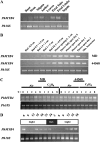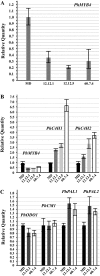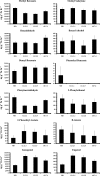PhMYB4 fine-tunes the floral volatile signature of Petunia x hybrida through PhC4H
- PMID: 21068208
- PMCID: PMC3022401
- DOI: 10.1093/jxb/erq342
PhMYB4 fine-tunes the floral volatile signature of Petunia x hybrida through PhC4H
Abstract
In Petunia × hybrida cv 'Mitchell Diploid' (MD), floral volatile benzenoid/phenylpropanoid (FVBP) biosynthesis is controlled spatially, developmentally, and daily at molecular, metabolic, and biochemical levels. Multiple genes have been shown to encode proteins that either directly catalyse a biochemical reaction yielding FVBP compounds or are involved in metabolite flux prior to the formation of FVBP compounds. It was hypothesized that multiple transcription factors are involved in the precise regulation of all necessary genes, resulting in the specific volatile signature of MD flowers. After acquiring all available petunia transcript sequences with homology to Arabidopsis thaliana R2R3-MYB transcription factors, PhMYB4 (named for its close identity to AtMYB4) was identified, cloned, and characterized. PhMYB4 transcripts accumulate to relatively high levels in floral tissues at anthesis and throughout open flower stages, which coincides with the spatial and developmental distribution of FVBP production and emission. Upon RNAi suppression of PhMYB4 (ir-PhMYB4) both petunia cinnamate-4-hydroxylase (PhC4H1 and PhC4H2) gene transcript levels were significantly increased. In addition, ir-PhMYB4 plants emit higher levels of FVBP compounds derived from p-coumaric acid (isoeugenol and eugenol) compared with MD. Together, these results indicate that PhMYB4 functions in the repression of C4H transcription, indirectly controlling the balance of FVBP production in petunia floral tissue (i.e. fine-tunes).
Figures






Similar articles
-
PhDAHP1 is required for floral volatile benzenoid/phenylpropanoid biosynthesis in Petunia × hybrida cv 'Mitchell Diploid'.Phytochemistry. 2014 Jul;103:22-31. doi: 10.1016/j.phytochem.2014.04.004. Epub 2014 May 6. Phytochemistry. 2014. PMID: 24815009
-
Petunia floral volatile benzenoid/phenylpropanoid genes are regulated in a similar manner.Phytochemistry. 2010 Feb;71(2-3):158-67. doi: 10.1016/j.phytochem.2009.09.036. Epub 2009 Nov 2. Phytochemistry. 2010. PMID: 19889429
-
Unraveling the regulation of floral fragrance biosynthesis.Plant Signal Behav. 2011 Mar;6(3):378-81. doi: 10.4161/psb.6.3.14339. Plant Signal Behav. 2011. PMID: 21673507 Free PMC article. Review.
-
Circadian clock gene LATE ELONGATED HYPOCOTYL directly regulates the timing of floral scent emission in Petunia.Proc Natl Acad Sci U S A. 2015 Aug 4;112(31):9775-80. doi: 10.1073/pnas.1422875112. Epub 2015 Jun 29. Proc Natl Acad Sci U S A. 2015. PMID: 26124104 Free PMC article.
-
Regulation of volatile benzenoid biosynthesis in petunia flowers.Trends Plant Sci. 2006 Jan;11(1):20-5. doi: 10.1016/j.tplants.2005.09.009. Epub 2005 Oct 12. Trends Plant Sci. 2006. PMID: 16226052 Review.
Cited by
-
The phenylpropanoid pathway is controlled at different branches by a set of R2R3-MYB C2 repressors in grapevine.Plant Physiol. 2015 Apr;167(4):1448-70. doi: 10.1104/pp.114.256172. Epub 2015 Feb 6. Plant Physiol. 2015. PMID: 25659381 Free PMC article.
-
Petunia as a model for MYB transcription factor action under salt stress.Front Plant Sci. 2023 Dec 8;14:1286547. doi: 10.3389/fpls.2023.1286547. eCollection 2023. Front Plant Sci. 2023. PMID: 38155855 Free PMC article.
-
The R2R3-MYB transcription factor FaMYB63 participates in regulation of eugenol production in strawberry.Plant Physiol. 2022 Mar 28;188(4):2146-2165. doi: 10.1093/plphys/kiac014. Plant Physiol. 2022. PMID: 35043961 Free PMC article.
-
Biochemical and transcriptomic analyses reveal that critical genes involved in pigment biosynthesis influence leaf color changes in a new sweet osmanthus cultivar 'Qiannan Guifei'.PeerJ. 2021 Oct 8;9:e12265. doi: 10.7717/peerj.12265. eCollection 2021. PeerJ. 2021. PMID: 34707941 Free PMC article.
-
Two-dimensional analysis provides molecular insight into flower scent of Lilium 'Siberia'.Sci Rep. 2018 Mar 29;8(1):5352. doi: 10.1038/s41598-018-23588-9. Sci Rep. 2018. PMID: 29599431 Free PMC article.
References
-
- Anterola AM, Jeon JH, Davin LB, Lewis NG. Transcriptional control of monolignol biosynthesis in Pinus taeda: factors affecting monolignol ratios and carbon allocation in phenylpropanoid metabolism. Journal of Biological Chemistry. 2002;277:18272–18280. - PubMed
-
- Colquhoun TA, Verdonk JC, Schimmel BC, Tieman DM, Underwood BA, Clark DG. Petunia floral volatile benzenoid/phenylpropanoid genes are regulated in a similar manner. Phytochemistry. 2010a;71:158–167. - PubMed
Publication types
MeSH terms
Substances
LinkOut - more resources
Full Text Sources
Other Literature Sources
Molecular Biology Databases

